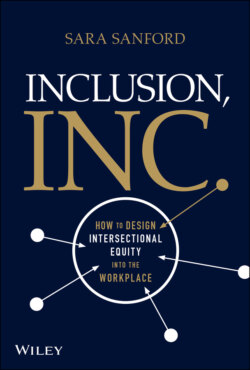Читать книгу Inclusion, Inc. - Sara Sanford - Страница 14
Stop the Trainings
ОглавлениеAmerican businesses spend $8 billion a year on diversity trainings.9
The quintessential diversity training came out of a 1960s workplace focused on compliance. Title VII of the Civil Rights Act of 1964 had made it illegal for employers to discriminate on the basis of race, religion, sex, or national origin, and a barrage of discrimination suits quickly followed. One of the most common remedies was a court-ordered mandate for the organization to train all employees in anti-discriminatory behavior. Many companies wanted to avoid costly and embarrassing lawsuits and preemptively implemented trainings, collecting signatures from employees afterward, acknowledging that employees understood the consequences of noncompliance.
Over decades, trainings expanded to accommodate LGBTQ employees, as well as other groups, and many workplaces now prefer to call them “unconscious bias” trainings. Even as they've evolved, one aspect of trainings hasn't changed: their ineffectiveness.
Morgan Stanley had trainings, before they shelled out $100 million to settle high-profile sex discrimination lawsuits. Bank of America's trainings didn't keep them from paying $160 million in racial discrimination settlements. Uber had trainings before paying millions to settle a class action suit brought by 420 female and minority engineers alleging gender and racial discrimination. These totals don't take into account the enduring costs of tarnished brands.
Multiple studies published in the Harvard Business Review conclude that diversity trainings don't work and often backfire. These studies found that white men who were asked to attend diversity trainings were actually less likely to hire and promote women and minorities.10 In general, participants who attend trainings in which they're told that we all hold biases leave those trainings believing that they are the exception, and their actions become more rooted in bias, not less.11
One of the reasons that biases are so insidious is that learning about them doesn't actually rid us of them. While becoming more aware of them can increase our ability to identify bias in others, it does not increase our ability to recognize it in ourselves. In fact, the stronger our biases are, the worse we are at seeing them, and the more neutral we believe we are. When this phenomenon is scaled, the more meritocratic we believe we are as an organization, the more biased our systems may be.
Chapter 3 describes in greater depth why trainings and other common approaches to DEI, such as affinity groups and the Lean In prescription, fall short. It also introduces new perspectives that can give businesses a competitive DEI advantage. For now, a quick preview: The difference between businesses that break the DEI inertia and those who stay stuck is defined by one key perspective shift: Equity isn't personal. It's systemic.
